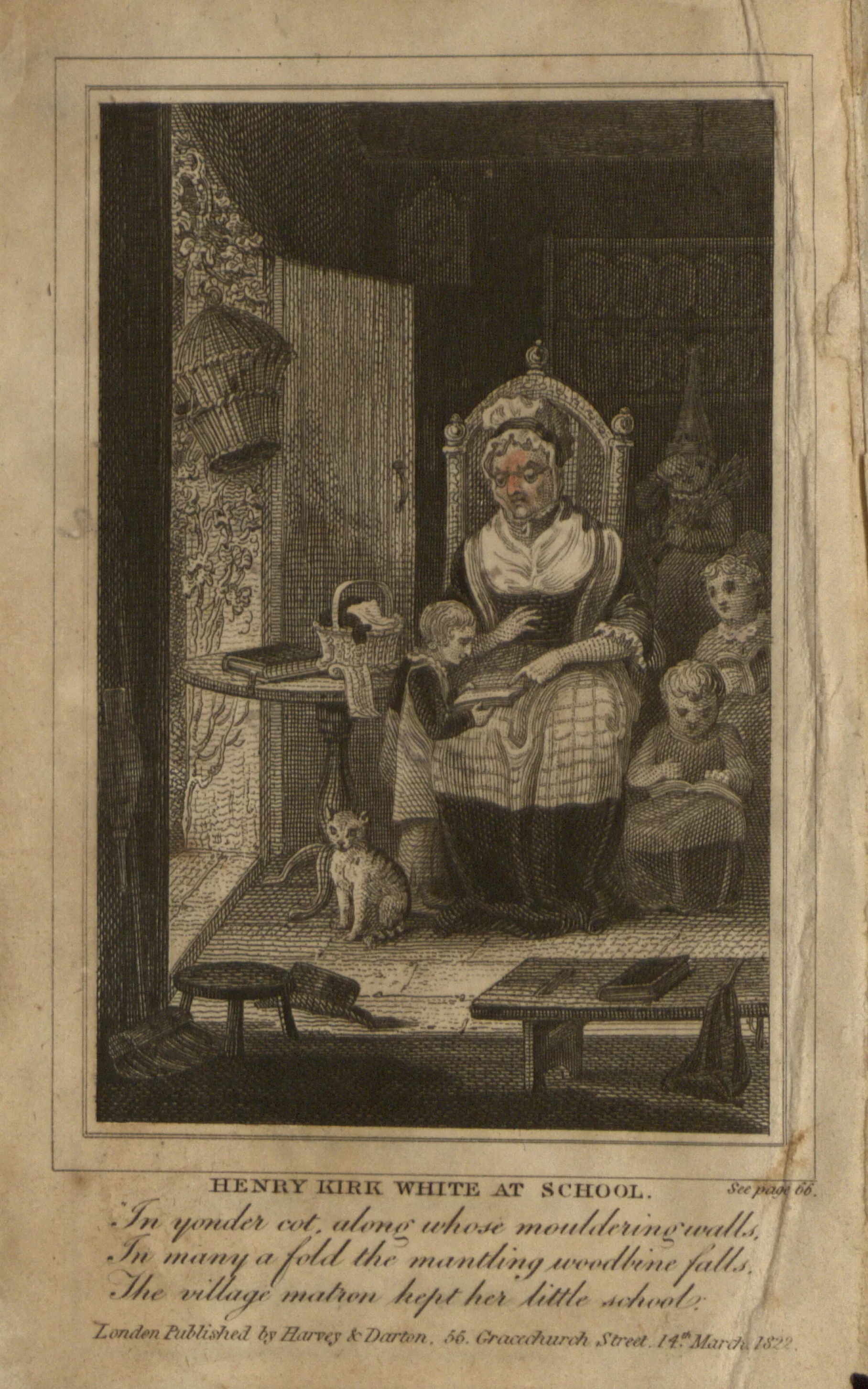Exhibit
Creation Date
1818
Height
12 cm
Width
7 cm
Medium
Genre
Description
This book illustration depicts Henry Kirke White, one of the text's discussed literary celebrities, as a fragile-looking child; consequently, the image alludes to White's early death and the tragically brief duration of his brilliant and promising career.
This picture shows Henry Kirke White as a boy, reading from a book held in the lap of an older woman. A cat sits near their feet. There are three other children to the woman's right, two of whom are reading; the other is crying. To Kirke's left is an open doorway, where a bird cage appears to hang from some foliage.
Henry Kirke White died in his rooms at Cambridge in 1806, at the age of twenty-one, and was buried in All Saints’ churchyard. Upon his death a large amount of unfinished poetry was found among his papers, which later formed the basis for the work that would cement his status as a promising poet who died before his prime (Martin).
Images in children’s educational texts of the period were intended to provide students with an example of the concept or subject being addressed.
The decision to devote the only illustration in this text, Buds of Genius (a book concerned with the early lives of celebrated figures as examples for child readers), to that of a child indicates a potential connection between visual stimulation for children and anxieties about their fragile physicality. Though images for children often created an association for the child—between scientific fact and anthropomorphized characters, for example—this image would more likely have had an associative impact on the parents of the child reader (Smith 834). Child mortality rates were high in the Romantic period: one doctor speculated that as many as half of children born in Manchester died before the age of five (Gibson 232). An awareness of this fact likely made the frontispiece of a young and frail-looking Henry Kirke White seem ominous. Compared to the children in the background his features are distinctly thin, hinting at his death at the age of 26. While the book’s subject matter seems aimed at moving its young readers forward from childhood into their (hopefully) prosperous adult years by exhorting them to follow the examples of the discussed celebrities, its sole image evokes a keen awareness of the reader’s fragility.
The "domestic" is another theme of this image. Due largely to Edmund Burke’s portrayal of family life in Reflections on the Revolution in France (1790), domesticity became a politicized concept, something that set Britain apart from France: Burke imagined Britain as a family, while France was the opposite, a destroyer of domestic peace (Tuite 125). The eighteenth century also saw a crystallization of women’s role in the concerns of the private sphere—reproduction, housekeeping and childcare—while the “pursuit of capital” was further set apart as a singularly male concern. The family unit became increasingly closed, as indicated by a rise of interest in the home itself—its contents, number of rooms, etc (Tuite 128). This specific notion of the domestic is reflected in this image of Henry Kirke White: three of his five siblings are depicted, and he is shown being educated by a woman within the home. As White was educated both at home and in schools, the decision to show him among his family is a conscious one; the illustration evokes the Romantic ideal of childcare as a domestic, and therefore family, concern.
Locations Description
The county town of Nottinghamshire, in north central England, is the traditional birthplace of Robin Hood. Still a relatively small city in the eighteenth century, it grew rapidly in the following century, becoming famous for its textile products.
Cambridge University, located fifty miles north of London, was founded in 1209 by a group of disgruntled clerks from Oxford. Historically, the school has a strong reputation for science and math.
Collection
Accession Number
Thordarson T 2934
Additional Information
Bibliography
Brown, Gillian. "The Metamorphic Book: Children's Print Culture in the Eighteenth Century." Eighteenth-Century Studies 39.3 (2006): 351-362. Print.
Drotner, Kirsten. English Children and Their Magazines, 1751-1945. New Haven: Yale UP, 1988. Print.
Gibson, Lois Rauch, and Laura M. Zaidman. “Death in Children’s Literature – Taboo or Not Taboo?” Children’s Literature Association Quarterly 16.4 (1991): 232-34. Print.
Martin, Philip W. “White, Henry Kirke (1785–1806).” Oxford Dictionary of National Biography. Ed. H. C. G. Matthew and Brian Harrison. Oxford: OUP, 2004. Web. 28 April 2009.
Schiller, Justin G. "Artistic Awareness in Early Children's Books." Children's Literature 3 (1974): 177-185. Print.
Smith, Jad. “Custom, Association, and the Mixed Mode: Locke's Early Theory of Cultural Reproduction.” ELH 73.4 (2006): 831-853. Print.
Tuite, Clara. “Domesticity.” An Oxford Companion to The Romantic Age: British Culture 1776-1832. Gen. Ed. Iain McCalman. Oxford: Oxford UP, 1999. Print.
Ward, William S. "Was Henry Kirke White a Victim of the Review Press?" Modern Language Notes 60.5 (1945): 337-338. Print.

